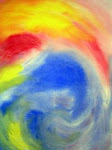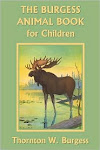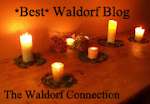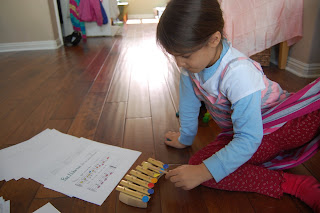
I have been meaning to post about this wonderful program for a while now, yet every time I sat down to do it, I would get intimidated, wondering *how* I could properly do it the justice it deserves as it truly encompasses so very much - how can I wrap it up into a neat little blog post, but I'll do my best...
I have heard it said before that in a Waldorf school, "Music is the thread that weaves the academic day together." In the early years, the child is exposed to singing and music through the mother, caregiver, or teacher. In Grade 1, introduction to the pentatonic instruments usually begins - via the pentatonic flute.
In Grade 1, the student receives two languages in a Waldorf school, usually Spanish and German. One of the best ways to teach a second language to a child is through song. As homeschoolers, teaching music and foreign language can seem very intimidating at times.
The AMHC Program, created by Naturopath Dr. Aurore Henze does just that - teaching pentatonic music and foreign language, with the added element of color and sound therapy woven effortless into the lessons. We are so enjoying this program! It encompasses songs in Spanish, German, and French...
Dr. Aurore Henze spent years studying and mastering alternative therapies. As a musician herself, it was only natural that she founded the AMHC and created a healing and holistic music program which encompasses color and sound therapy, along with foreign language and music appreciation and development. She is a waldorf inspired homeschooler to three lovely children. There is much to this program, though to implement it, all you really need is a few basic materials - mainly the book, some stickers, and a pentatonic instrument (glockenspiel, flute, or lyre are the ones she recommends) - though a complete list of recommended supplies is included in the book. Most waldorf inspired homeschooling parents will have block crayons and watercolor paints, etc.
The program is easily laid out with each note of the pentatonic scale being assigned a therapeutic color based on the scientific research of color and sound by Dr. Darius Dinshah, author of "Let there be Light".

Marking each note on the pentatonic glockenspiel (ours is an Auris from Sweden), the child can easily follow along with the sheet music, which is also color coded. They say the notes and then the colors as they play along.

And then they can sing the lyrics once the song is mastered.

We had purchased these maths blocks and they work very nicely with the program as manipulatives that the child can place alongside the notes to reinforce the colors and songs they are playing, as recommended in the program.

They can also be used for math or for free play and building.

While neither of the girls is receiving piano lessons just yet, they love to tinker around on the piano and Charley is beginning to make up her own simple songs. I do feel that as we make the connection from the notes of the glockenspiel, to the piano, to the pentatonic flute - there is a comfort and a confidence that is newly emerging. This program does a wonderful job of not intimidating the child and allowing them the pleasure of being able to *read* the music to play a song which sounds fantastic thanks to the perfect pentatonic scale.

While we made our way through the pages in the Phase I book, I got out a pentatonic flute book I picked up at the Steiner College Bookstore which I absolutely love called, "Waldorf Teachers' Companion to the Pentatonic Flute" by John Miles.

Using Dr. Aurore's color therapy suggestions, I made crayon marks under the notes to help us learn to play these songs with the glockenspiel.

And then we learned the song on our Choroi Pentatonic Flute.


So I love that this program can overlap with other songbooks so that it grows *endlessly* with the child (keep in mind that there are two additional phases!). While I admit that I have not done much research on color therapy, I have heard some rave reviews about it from the holistic community. Seeing how well my daughters are taking to it and the success that Dr. Aurore has had with her own children (including her son who was not only healed from a diagnosis of autism, but was the youngest American musician to be invited to study at Interlochen in 2005) I feel very positive about the merits of this program.
If you are a Lifetime Member of Kristie Burns' Earthschooling program, you can access Phase I, including a video showing Dr. Aurore and her talented children as they showcase the program. I think that the program is going to be offered soon via amazon, as well. It can be purchased here and I'm sure Dr. Aurore would be happy to answer any questions about it!
I particularly loved one section where she compared Memorization to Comprehension in relation to Helen Keller and Anne Sullivan, her teacher, who insisted upon true comprehension. In music, there are many children (including myself as a youngster) who could read music and play the piano, but I did not really *understand* it, as I can not sit down and create it with that ultimate trust and surrender to the true comprehension that is music. I love that in early Waldorf education, the child learns by ear, by imitation as s/he hears and sees the teacher/parent leading. This program encourages this through humming as the notes are learned - matching pitch and can be taken further with harmonies. The confidence it will build through the years can not be underestimated as within creation of any kind, comes true happiness and satisfaction. I believe this program strives for true music comprehension. There is much more to be said, but then I will be writing a novel - lol! If you have been looking for a program to enhance your music and foreign language studies, this just might be what you're looking for!





























Your daughters are so sweet- I love that sun shiny room with the wood floors and the piano-
ReplyDeleteyou have a magical waldorf house of love : )
Thanks Jen....
I am so so grateful to you for sharing this resource and your thoughts on it. I have struggled with the concept of and motivation behind pentatonic music...in fact have outright rejected it because of my inability to wrap my brain around it...and have felt that I was just going to have to miss out. All that you've written here (as well as what I gleaned from Dr Aurore's website) has sort of re-arranged the puzzle pieces for me so that I can look at this from a new perspective. I'm very excited to investigate further, and again, so grateful to you for putting it out there!
ReplyDeleteThanks Aurore :D We love your program, if you couldn't tell - lol!
ReplyDeleteCypress, I'm so glad this post opened up the door again to sharing petatonic music with your beautiful little girl. The way Aurore laid it out is very easy and if you get a book (like the pentatonic flute book I mentioned) to show you where to place your fingers for each note on the flute, you will be able to figure it out, even without a musical background. You could then even write down each letter of each note and transpose that to play on the glockenspiel, which already has the notes listed. Not sure if you have seen Our Little Nature Nest's blog, but her 3rd grade daughter has been recording songs on flute on Sunday nights. That has really helped me keep focused on learning this with the girls so that *we* can play as a family as the years go by. If you have any questions, feel free to contact Aurore. She is very sweet and helpful and have fun exploring!
Blessings,
Jen
oh my gosh! I am really appreciating finding your blog. It was recommended on google reader as I was managing my blog list there tonight..and it popped up. I live in northern california, and have an almost 6 year old in a kindergarten at a waldorf charter school, which we love. I am looking at your posts from last year to get inspired for arts and crafts for my little girls kindergarten level. All of your photos of art projects are very inspiring and I am so so excited to do some of these crafts with my daughter. I am a nutritionist and we do lots of cooking..but not so great with the art! And, I am an identical twin too, so it is really lovely seeing your twins! Thank you!
ReplyDeleteThis was lovely to read about Jen, thank you so much for posting about it. I will email Aurore:)
ReplyDeleteSounds like a very lovely program. We have the same blocks! :)
ReplyDeleteWe used that verse "brave & true, I will be" to learn our 3 & 6 times tables. It has been a favorite.
ReplyDeletewonderfully explained Jen! Thank you for sharing in such detail...I can feel your love for what it is creating in your family.
ReplyDeleteSuch a special way to learn music. I love the colors, the music in different languages, and how you used the glockenspiel.
ReplyDeleteI am very interested in this program for my kids. I see there are 3 parts to the program: A lesson planner, song book, and DVD. When you say "all you need is the book"- which book do you mean? Thanks :)
ReplyDelete